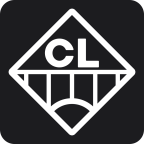Using laser cutting templates can produce precise works. You can follow the steps below to choose different materials and make small or large templates.

Step 1: Obtaining the Artwork
The first step is to choose the design, this can vary from making a business logo or creating some vector artwork for your stencil. Hopefully the business logo is a high quality image but most of the time I have to trace some distorted JPG they sent to make it work. The number one challenge of making laser cut stencils is creating artwork without any islands in the design. Another consideration you have to make is the materials you are choosing to laser cut the stencil out of. These factors and the original design will determine how much you have to edit the image to make a stencil.
Step 2: Converting to Vector Format
Once you have the artwork, the next step is to convert it into a vector format. Vector images are essential for laser cutting because they allow for precise and scalable designs and they can communicate well with the laser cutter software. You also have to remove all of the islands similar to the image above which shows our original logo and the edits I made to the logo so it would stay together in one piece. This will change the image slightly but it isn't that impactful to actually change the design. The following steps are a breif explanation on how to create your vector in Inkscape.
1. Import the Image: Open Inkscape and import your image.
2. Trace Bitmap: Select the image, go to Path > Trace Bitmap. Adjust the settings as needed and click OK.
3. Edit Path: Once the image is traced, you can edit the path to ensure all elements are correctly outlined.
4. Remove Islands: Slightly edit artwork as required so stencil stays together and remains rigid.
5. Save as SVG: Save the file as an SVG (Scalable Vector Graphics) format, which is suitable for laser cutting.
Step 3: Preparing the Stencil Design - Material Selection
Now that we have artwork that wont fall apart we will select our material. You have many options and they all have their uses. I have made stencils out of mylar, acrylic, card stock, card board, paper, PTEG, wood and others. It is important that you only cut materials suitable for laser cutting.
Step 4: Making a Test Cut
Before committing to a final cut, it’s wise to make a test cut. This allows you to check the accuracy of your design and make any necessary adjustments. Use a small piece of your chosen material and run a test cut to ensure everything is perfect with the design. sometimes i make a full size sample and spray it to make sure the design works for the application.
Step 5: Creating the Stencil
Once your design is finalized and tested, you can proceed to cut the full stencil. For larger stencils, consider breaking the design into smaller sections that can be pieced together. This is particularly useful for very large stencils, such as those up to 25 feet wide.
Materials for Stencil Making: Pros and Cons
Stencils can be made from a variety of materials, each with its own advantages and disadvantages. Here’s a breakdown of some common materials used in stencil making:
Material Breakdown
Mylar
There are various widths of mylar material suitable for laser cutting. This is a great material to choose for reuse. The thinner types of Mylar materials are the best for rolling a stencils with paint rollers, they are all good for spraying paint. This material is flimsy but it is also strong which is good for intricate cuts. You could easily clean these with the cleaners suitable to the pant materials you use. The best widths of materials to use are 4mm 7.5mm and 10mm depending on the application. Larger stencils can also be made from this material but the materials I use listed below usually meet most applications.
Pros: Durable, reusable, available in multiple thicknesses, flexible.
Cons: More expensive than paper or card stock.
Best For: Detailed and reusable stencils.
Acrylic
Acrylic Stencils are a little bit thicker and more durable. There are paper thin acrylics but I mostly use acrylic to make rigid stencils. The best application for rigid material acrylic stencils are for leather work and fabric patterns, so you could easily trace the shapes onto leather or fabrics and cut by hand. These stencils will last forever when used in this application.
Pros: Extremely durable, reusable, perfect for repeated heavy-duty use.
Cons: Requires higher laser power, more expensive.
Best For: Industrial applications, long-term use.
Card Stock
There are different products you could use but I usually get a pack of larger size sheets, so I could have lots of materials for lots of projects on the laser cutter.
Pros: Affordable, easy to cut, you could cuts lots of variations for one time use.
Cons: Not durable, limited to single or few uses.
Best For: Simple, one-time projects.
Adhesive-Backed Mylar
Pros: Easy to use, stays in place during application.
Cons: Higher cost.
Best For: Detailed work requiring precision placement.
I usually make this or special order it from a local supplier.
Oil Board
Pros: Resistant to oil and solvents, durable.
Cons: Can be challenging to cut with intricate designs.
Best For: Industrial stencils, signage.
Example: Large Stencils
I have made stencils up to 25 feet wide and for a stencil like this consider using a durable material like Mylar, or paper this Acrylic to ensure the stencil maintains its shape and integrity during application. Break the design into manageable sections for your laser to digest and make sure you have overlapping portions so you could glue this bad boy together to make a continuous stencil.
By choosing the right material and following these steps, you can create high-quality stencils for a variety of applications, from crafting to industrial use.








